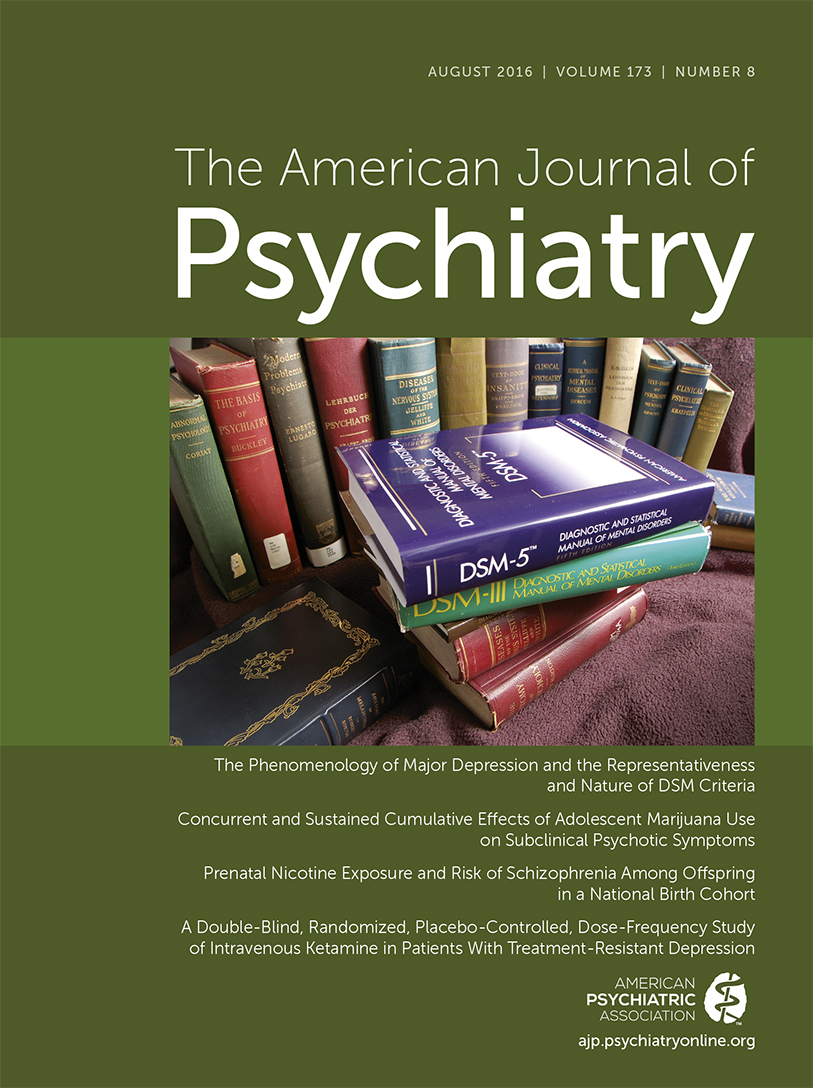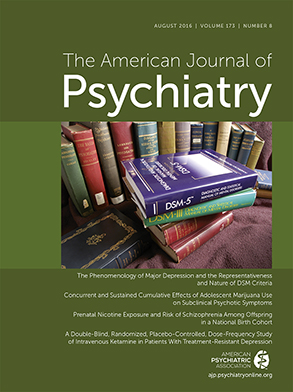The randomized, double-blind, placebo-controlled trial of intravenous ketamine published in this issue (
1) is a significant step forward in the investigation of ketamine’s antidepressant effect. The results confirm previously available open-label data showing a sustained antidepressant response and decreasing dissociative symptoms in a 4-week trial. The trial also documented changes in suicidality, which is a high-priority rationale for considering rapidly acting new treatments, but did not find an effect of ketamine. Twice-weekly and thrice-weekly administration appear to be equivalent in efficacy, an important parameter for the design of larger trials. The trial was not intended to guide clinical use. The duration of the trial, 4 weeks of active treatment, is only a brief intervention for a chronic illness, and the numbers of patients were small, with fewer than 20 per group. The important posttreatment follow-up phase had too few participants—two on day 18 for twice-weekly ketamine and seven for thrice-weekly—to allow assessment of longer-term effects. There was also no active comparator. The authors were concerned about maintaining the blind design, because most subjects can recognize the dissociative effects of ketamine. Such limitations are understandable in research on difficult-to-address questions, such as the treatment of severely refractory depression. Nevertheless, they preclude the drawing of any strong conclusions from these new data. Thus, while the study represents an important investigational step, it does not provide enough information to support clinical use.
Ketamine’s potential antisuicidal effect in patients with treatment-resistant depression, although not observed in this study, nonetheless continues to be an impetus for both clinical and basic research. Clinically, it offers the possibility that a seemingly untreatable condition may be amenable to new therapies. Ketamine has many actions, but which ones are responsible for this remarkable therapeutic effect are unknown. Basic research continues to identify new mechanisms, in addition to ketamine’s known effects on NMDA-type glutamate receptors, opioid receptors, and catecholaminergic synapses (
2).
Ketamine is already marketed as an intravenous anesthetic drug, as most clinicians know. However, this trial was sponsored by Johnson & Johnson as part of what the company has promoted in its business plans as a billion-dollar psychotropic drug program (
3). It is not too early for clinicians and public health authorities to be considering possible advantages and disadvantages in the potential clinical use of ketamine.
Although the current intravenous formulation limits distribution to physicians, even with this limited distribution, there are reports of patients developing significant behavioral side effects after contriving to receive multiple doses from the same or different physicians (
4). The company is now investigating a nasal spray (
5). Removing the need for intravenous administration could open the possibility of direct distribution to patients and could easily contribute to many more problems with patients’ exceeding dose and interval limits. Ketamine’s stimulant and opioid properties make it particularly susceptible to overuse, especially when the dose release is rapid after either intravenous or intranasal administration. In animal models it produces some self-administration behavior, consistent with liability to addiction, but less than that produced by cocaine (
6). A failure to adequately consider both medically indicated and diverted distributions for addiction and abuse has led to the oxycodone epidemic. Steps need to be taken to prevent similar issues with intranasal ketamine.
Depression that does not respond to accepted first-line antidepressant therapies—antidepressant drugs and psychotherapy—is a significant health problem with high morbidity and mortality. New, effective treatments are needed. In the search for such treatments, interventions with the significant possibility of significant adverse effects are being considered. Invasive brain surgery for deep brain stimulation and ketamine infusion are certainly two such treatments. Comparisons of remission levels are potentially instructive. Risperidone, added to an antidepressant that was producing a suboptimal response, produced a 25% remission rate, compared with 11% for placebo (
7). Ketamine produced a 38% remission rate, compared with 8% for placebo. These numbers do not support conclusions, but they do support the inclusion of active comparators in future clinical trials.
A problem in the risk-benefit assessment is the lack of a definition of treatment-resistant depression. The ketamine trial reported here used a liberal threshold, namely, two failed drug trials, only one of which was in the current episode. Psychotherapy was not required. This criterion is similar to that used for the initial trials of aripiprazole and risperidone in depression. Although there are no estimates of how frequently such criteria are met, the findings from the Sequenced Treatment Alternatives to Relieve Depression (STAR*D) study indicate that over one-third of patients initially treated with an antidepressant would meet this requirement (
8). Given the availability of apparently safer treatments—psychotherapies, antipsychotics, ECT, and transcranial magnetic stimulation—a liberal threshold for the clinical use of ketamine may not be warranted.
The Centers for Medicare and Medicaid Services recently convened a panel to assess the medical evidence for a definition of treatment-resistant depression. Historically, psychiatrists have resisted the rigorous definition of treatment-resistant depression and argued that physicians should be able to tailor treatments to individual needs and that specific steps of therapy should not be required. For ketamine, however, public health priorities to prevent indiscriminate use may modify this position. The criterion for treatment-resistant depression may not be absolute, but rather its stringency may need to be adjusted relative to the risks of the second-line treatments being contemplated.
The promise of ketamine in refractory depression now requires that a more thoughtful development plan be developed. If ketamine does move to market as an intravenous or intranasal formulation for the treatment of depression, the labeling will need to indicate the clinical context in which it has been proven to be safe and effective. How a drug whose current usage is short-term should be used clinically for a chronic illness and how its distribution should be controlled are as yet unaddressed issues. Although the U.S. Food and Drug Administration has the primary responsibility for labeling, the profession itself may need to address practice guidelines early in the process.

